
Duchy of Ziebice
Encyclopedia
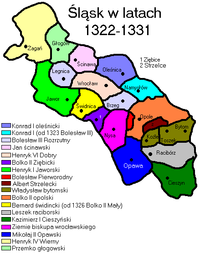
Duchies of Silesia
The Duchies of Silesia resulted from divisions of the original Duchy of Silesia after 1138.In accordance with the last will and testament of Duke Bolesław III Wrymouth, the Kingdom of Poland was, upon his death in 1138, divided into five hereditary provinces distributed among his sons, including...
, with a capital in Münsterberg
Ziebice
Ziębice is a town in Ząbkowice Śląskie County, Lower Silesian Voivodeship, in south-western Poland. It is the seat of the administrative district called Gmina Ziębice. Prior to 1945 it was in Germany...
(Ziębice). Existing from 1321/1322 to 1742, it was located in what came to be referred to as Lower Silesia
Lower Silesia
Lower Silesia ; is the northwestern part of the historical and geographical region of Silesia; Upper Silesia is to the southeast.Throughout its history Lower Silesia has been under the control of the medieval Kingdom of Poland, the Kingdom of Bohemia and the Austrian Habsburg Monarchy from 1526...
. Its territory is similar to modern Ząbkowice Śląskie County
Zabkowice Slaskie County
Ząbkowice Śląskie County is a unit of territorial administration and local government in Lower Silesian Voivodeship, south-western Poland. It came into being on January 1, 1999, as a result of the Polish local government reforms passed in 1998. The county covers an area of...
in Poland
Poland
Poland , officially the Republic of Poland , is a country in Central Europe bordered by Germany to the west; the Czech Republic and Slovakia to the south; Ukraine, Belarus and Lithuania to the east; and the Baltic Sea and Kaliningrad Oblast, a Russian exclave, to the north...
.
Piast rule
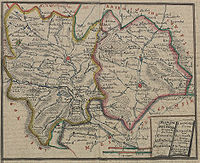
Bolko I the Strict
Bolko I the Strict also known as the Raw or of Jawor , was a Duke of Lwówek during 1278-81 and Jawor since 1278 , sole Duke of Lwówek since 1286, Duke of Świdnica-Ziębice since 1291.He was the second son of Bolesław II the Bald, Duke of Legnica by his first wife Hedwig, daughter of...
inherited the towns of Münsterberg
Ziebice
Ziębice is a town in Ząbkowice Śląskie County, Lower Silesian Voivodeship, in south-western Poland. It is the seat of the administrative district called Gmina Ziębice. Prior to 1945 it was in Germany...
(Ziębice) and Frankenstein
Zabkowice Slaskie
Ząbkowice Śląskie is a town in Lower Silesian Voivodeship in south-western Poland. It is the seat of Ząbkowice Śląskie County, and of the smaller administrative district called Gmina Ząbkowice Śląskie....
(Ząbkowice Śląskie). Around 1300, he finished a castle in Münsterberg. When he died in 1301, his possessions were divided among his three sons. The youngest son, Bolko II Ziębicki, received Münsterberg (Ziębice) in 1321 and was the first to style himself Duke of Münsterberg (Duke of Ziębice). He resided in the town's castle. After he demanded land from the diocese's domains, a long-running dispute with the Bishop of Breslau arose, and the bishop imposed an interdict
Interdict
The term Interdict may refer to:* Court order enforcing or prohibiting a certain action* Injunction, such as a restraining order...
over the duchy several times, while the duke was anathematized. After the siege of Frankenstein by the Moravia
Moravia
Moravia is a historical region in Central Europe in the east of the Czech Republic, and one of the former Czech lands, together with Bohemia and Silesia. It takes its name from the Morava River which rises in the northwest of the region...
n Margrave
Margrave
A margrave or margravine was a medieval hereditary nobleman with military responsibilities in a border province of a kingdom. Border provinces usually had more exposure to military incursions from the outside, compared to interior provinces, and thus a margrave usually had larger and more active...
and later by Holy Roman Emperor
Holy Roman Emperor
The Holy Roman Emperor is a term used by historians to denote a medieval ruler who, as German King, had also received the title of "Emperor of the Romans" from the Pope...
Charles IV
Charles IV, Holy Roman Emperor
Charles IV , born Wenceslaus , was the second king of Bohemia from the House of Luxembourg, and the first king of Bohemia to also become Holy Roman Emperor....
, Bolko II recognized Bohemia
Bohemia
Bohemia is a historical region in central Europe, occupying the western two-thirds of the traditional Czech Lands. It is located in the contemporary Czech Republic with its capital in Prague...
n suzerainty on 29 August 1336 in the Treaty of Straubing. Bolko II died in 1341; he was buried in the church of the Heinrichau
Henryków, Lower Silesian Voivodeship
Henryków is a village in the administrative district of Gmina Ziębice, within Ząbkowice Śląskie County, Lower Silesian Voivodeship, in south-western Poland. Prior to 1945 it was in Germany....
(Henryków) monastery, a monastery he generously supported during his lifetime.
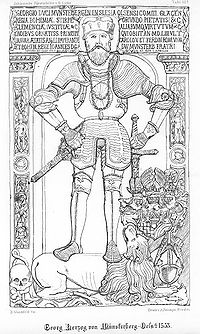
Nicholas the Small
Nicholas the Small was a Duke of Münsterberg since 1341 until his death.He was the eldest child and only son of Duke Bolko II of Münsterberg and his wife Bonne , daughter of Louis of Savoy, Baron of Vaud.-Life:...
, was Duke of Münsterberg until 1358. In the year of his father's death, he paid homage to Bohemian King John of Luxembourg and his son Charles
Charles IV, Holy Roman Emperor
Charles IV , born Wenceslaus , was the second king of Bohemia from the House of Luxembourg, and the first king of Bohemia to also become Holy Roman Emperor....
. Nicholas' successor, Bolko III
Bolko III of Ziębice
Bolko III of Münsterberg was a Duke of Münsterberg since 1358 until his death, and ruler over Gleiwitz during 1369–1373....
, died in 1410. The next dukes, the brothers Henry († 1420) and Jan
Jan of Ziębice
John I of Münsterberg was a Duke of Münsterberg since 1410 .He was the second son of Duke Bolko III of Münsterberg by his wife Euphemia, daughter of Duke Bolesław of Bytom.-Life:...
, ruled the duchy together until 1420; afterward Jan ruled alone. Jan died on 27 December 1428 at the Battle of Altwilmsdorf against the Hussite
Hussite
The Hussites were a Christian movement following the teachings of Czech reformer Jan Hus , who became one of the forerunners of the Protestant Reformation...
s. With him the Piast
Silesian Piasts
The Silesian Piasts were the oldest line of the Piast dynasty beginning with Władysław II the Exile, son of Bolesław III Wrymouth, Duke of Poland...
Dukes of Münsterberg died out.
Bohemian rule
With the death of Duke Jan, the duchy passed to BohemiaBohemia
Bohemia is a historical region in central Europe, occupying the western two-thirds of the traditional Czech Lands. It is located in the contemporary Czech Republic with its capital in Prague...
n King Sigismund
Sigismund, Holy Roman Emperor
Sigismund of Luxemburg KG was King of Hungary, of Croatia from 1387 to 1437, of Bohemia from 1419, and Holy Roman Emperor for four years from 1433 until 1437, the last Emperor of the House of Luxemburg. He was also King of Italy from 1431, and of Germany from 1411...
, who pledged it to Půta the Younger, Lord of Častolovice
Castolovice
Častolovice is a market town in the Hradec Králové Region of the Czech Republic. It has around 1,600 inhabitants.The village lies 20 kilometers from Hradec Králové and was purportedly settled by Častolov of the Hronovec family in 1342...
, in 1429. After Půta the Younger's death in 1434, his widow, Anna of Koldice, kept the bond and ruling claims. However, the estates of Münsterberg favored Countess Euphemia of Oettingen
Euphemia of Ziębice
Euphemia of Münsterberg , also known as Euphemia, Countess of Oettingen, was a princess member of the Piast dynasty in the Münsterberg branch, by marriage Countess of Öttingen and sovereign Duchess of Münsterberg during 1435–1443.She was the third child and eldest daughter of Duke Bolko III of...
, a niece of the last duke. She gained Münsterberg in 1435, but abandoned it a year later because of continuing disputes. Although Anna of Koldice sold her possessions in 1440 to Hynek Krušina of Lichtenburg
Hynek Krušina of Lichtenburg
Hynek Krušina of Lichtenburg was a Hussite commander and governor and lien holders of the County of Glatz, the Duchy of Münsterberg and the city of Ząbkowice Śląskie ....
, whom she married shortly thereafter, new succession disputes with the estates erupted, in which several Silesian princes supported the estates of Münsterberg. In 1442, Hynek Krušina looted the Heinrichau monastery, since it was particularly associated with the estates. After lengthy negotiations, the estates of Münsterberg on 25 April 1443 chose Duke Vilém of Opava as their new ruler. His claims were justified by two reasons. First, he was the son of Přemyslid
Premyslid dynasty
The Přemyslids , were a Czech royal dynasty which reigned in Bohemia and Moravia , and partly also in Hungary, Silesia, Austria and Poland.-Legendary rulers:...
Přemysl of Opava and Catherine, the sister of Jan of Ziębice
Jan of Ziębice
John I of Münsterberg was a Duke of Münsterberg since 1410 .He was the second son of Duke Bolko III of Münsterberg by his wife Euphemia, daughter of Duke Bolesław of Bytom.-Life:...
(† 1428), the last Piast of Münsterberg. Second, he was married to Salome, a daughter of the late Půta the Younger. Vilém joined forces with the Bishop of Wroclaw and the Silesian princes, who fought against Hynek Krušina. Although Hynek Krušina had not legally abandoned his claims, the dispute was settled in 1444.
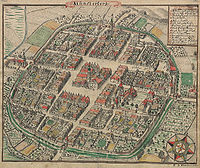
George of Podebrady
George of Kunštát and Poděbrady , also known as Poděbrad or Podiebrad , was King of Bohemia...
. The King handed his possessions down to his sons Victor
Victor of Poděbrady
Victor, Duke of Münsterberg Victor, Duke of Münsterberg Victor, Duke of Münsterberg (also: Victor, Duke of Münsterberg and Opava; ; (29 May 1443 in Cieszyn – 30 August 1500 in Cieszyn) was an Imperial Count from 1459 and Count of Kladsko...
, Henry the Elder
Henry I, Duke of Münsterberg-Oels
Henry the Elder of Münsterberg was an Imperial Count and Count of Kladsko. He was also Duke of Silesian duchies Münsterberg and Oels and 1465–1472 Duke of Opava...
and Henry the Younger
Henry the Younger of Poděbrady
Henry the Younger of Poděbrady was an Imperial Count and Count of Glatz. From 1462 to 1471, he served as Duke of Münsterberg jointly with his older brothers Victor and Henry the Elder. He also ruled Duchy of Opava jointly with his brothers from 1365 to 1372...
in 1472. Henry the Older, who was married to Ursula of Brandenburg, a daughter of Elector Albrecht III of Brandenburg, received the Duchy of Münsterberg. He also got Frankenstein
Zabkowice Slaskie
Ząbkowice Śląskie is a town in Lower Silesian Voivodeship in south-western Poland. It is the seat of Ząbkowice Śląskie County, and of the smaller administrative district called Gmina Ząbkowice Śląskie....
(Ząbkowice Śląskie), the County of Kladsko
County of Kladsko
The County of Kladsko was a historical administrative unit in the Kingdom of Bohemia and later in the Kingdom of Prussia with its capital at Kłodzko on the Nysa river...
, the dominion of Náchod
Náchod
Náchod -History:Náchod was founded in 14th century by knight Hron of Načeradice, who founded a castle on a strategical place, where local trade road reaches the defile called Branka. The first written note dates back to 1254.-Castle:...
, and the former east Bohemian possessions of Půta the Younger. In 1488, he built a castle in Münsterberg and in 1495 obtained the duchy of Oels
Duchy of Oels
The Duchy of Oels or Duchy of Oleśnica was one of the duchies of Silesia, with the capital in Oleśnica, Poland.Initially part of the Piast Duchy of Wrocław, the Oleśnica area became part of the Duchy of Głogów in 1294, following an armed conflict between Duke Henry III and Henry V the Fat, Duke of...
. He resided in Kladsko (Glatz, Kłodzko), where he died in 1498.
He was followed by his sons Albert, George and Charles, who ruled together. The latter moved his residence to Frankenstein in 1530, where he died six years later and was buried in the parish church. His sons, Joachim, Henry, John and George, supporters of the Reformation
Protestant Reformation
The Protestant Reformation was a 16th-century split within Western Christianity initiated by Martin Luther, John Calvin and other early Protestants. The efforts of the self-described "reformers", who objected to the doctrines, rituals and ecclesiastical structure of the Roman Catholic Church, led...
, ruled jointly until 1542. In the same year, they pledged the indebted duchy to their uncle, Duke Frederick II of Legnica († 1547). In 1551, Bohemian King Ferdinand I redeemed the duchy from Duke Frederick III of Legnica. Between 1552 and 1559 it belonged to Queen Isabella of Hungary as a pledged lordship. In 1559, the duchy passed into the hands of Duke John of Oels, a son of Charles I of Münsterberg, and thus returned to the house of Poděbrady.
After John's successor, Charles Christoph, died childless in 1569, Münsterberg returned to the crown of Bohemia. Because of his contributions to the House of Habsburg
Habsburg
The House of Habsburg , also found as Hapsburg, and also known as House of Austria is one of the most important royal houses of Europe and is best known for being an origin of all of the formally elected Holy Roman Emperors between 1438 and 1740, as well as rulers of the Austrian Empire and...
, King Ferdinand III
Ferdinand III, Holy Roman Emperor
Ferdinand III was Holy Roman Emperor from 15 February 1637 until his death, as well as King of Hungary and Croatia, King of Bohemia and Archduke of Austria.-Life:...
in 1654 gave the duchy to Prince of the Holy Roman Empire, Count John Weikhard of Auersperg
Principality of Auersperg
Auersperg was an Austrian princely family, which held estates in Austria and Thengen...
.
Prussian rule
After the First Silesian WarSilesian Wars
The Silesian Wars were a series of wars between Prussia and Austria for control of Silesia. They formed parts of the larger War of the Austrian Succession and Seven Years' War. They eventually ended with Silesia being incorporated into Prussia, and Austrian recognition of this...
and the incorporation of Silesia into Prussia
Prussia
Prussia was a German kingdom and historic state originating out of the Duchy of Prussia and the Margraviate of Brandenburg. For centuries, the House of Hohenzollern ruled Prussia, successfully expanding its size by way of an unusually well-organized and effective army. Prussia shaped the history...
in 1742, the Auerspergs retained their possessions. The duchy however was converted into a State country
State country
State country was a unit of administrative and territorial division in the Bohemian crown lands of Silesia and Upper Lusatia, existing from 15th to 18th centuries. These estates were exempt from feudal tenure by privilege of the Bohemian kings...
. In 1791, Prince Charles Joseph Anton of Auersperg sold the duchy to Prussian King Frederick William II
Frederick William II of Prussia
Frederick William II was the King of Prussia, reigning from 1786 until his death. He was in personal union the Prince-Elector of Brandenburg and the sovereign prince of the Principality of Neuchâtel.-Early life:...
.
Dukes of Münsterberg
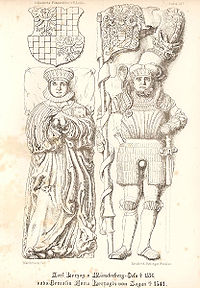
- 1301–1341 Bolko IIBolko II of ZiębiceBolko II of Ziębice was a Duke of Jawor-Lwówek-Świdnica-Ziębice in Poland from 1301 to 1312 , of Świdnica-Ziębice from 1312 to 1322 , and sole Duke of Ziębice from 1322 until his death.He was the fourth son of Bolko I the Strict, Duke of Jawor-Lwówek-Świdnica-Ziębice, by his wife Beatrix,...
(† 1341) - 1341–1351 Nicholas the SmallNicholas the SmallNicholas the Small was a Duke of Münsterberg since 1341 until his death.He was the eldest child and only son of Duke Bolko II of Münsterberg and his wife Bonne , daughter of Louis of Savoy, Baron of Vaud.-Life:...
(† 1358), son of Bolko II. - 1351–1410 Bolko IIIBolko III of ZiębiceBolko III of Münsterberg was a Duke of Münsterberg since 1358 until his death, and ruler over Gleiwitz during 1369–1373....
(† 1410), son of Nicholas the Small - 1410–1420 Henry IIHenry II of ZiębiceHenry II of Münsterberg was Duke of Münsterberg since 1410 until his death .He was the third son of Duke Bolko III of Münsterberg by his wife Euphemia, daughter of Duke Bolesław of Bytom.-Life:...
(† 1420), son of Bolko III - 1410-1428 John IJan of ZiębiceJohn I of Münsterberg was a Duke of Münsterberg since 1410 .He was the second son of Duke Bolko III of Münsterberg by his wife Euphemia, daughter of Duke Bolesław of Bytom.-Life:...
† 1428, son of Bolko III
The duchy passes to Bohemian king Sigismund
Sigismund, Holy Roman Emperor
Sigismund of Luxemburg KG was King of Hungary, of Croatia from 1387 to 1437, of Bohemia from 1419, and Holy Roman Emperor for four years from 1433 until 1437, the last Emperor of the House of Luxemburg. He was also King of Italy from 1431, and of Germany from 1411...
.
- 1429–1434 Půta the Younger of Častolovice († 1434)
- 1435–1436 EuphemiaEuphemia of ZiębiceEuphemia of Münsterberg , also known as Euphemia, Countess of Oettingen, was a princess member of the Piast dynasty in the Münsterberg branch, by marriage Countess of Öttingen and sovereign Duchess of Münsterberg during 1435–1443.She was the third child and eldest daughter of Duke Bolko III of...
(† 1447), sister of John I, renounced her right - 1437–1440 Anna († 1467), widow of Půta the Younger of Častolovice
- 1440–1443 Hynek Krušina von Lichtenburg († 1454), acquired the bonds of Anna, which he married in the same year
- 1443–1452 Vilém of Opava († 1452), son of PřemyslidPremyslid dynastyThe Přemyslids , were a Czech royal dynasty which reigned in Bohemia and Moravia , and partly also in Hungary, Silesia, Austria and Poland.-Legendary rulers:...
Přemysl of Opava and Katharine, sister of John I († 1428), the last Piast of Münsterberg. - 1452–1456 Arnošt of Opava († 1464), brother of Vilém; sold Münsterberg in 1456 to Bohemian king George of PoděbradyGeorge of PodebradyGeorge of Kunštát and Poděbrady , also known as Poděbrad or Podiebrad , was King of Bohemia...
. - 1456–1462 George of PoděbradyGeorge of PodebradyGeorge of Kunštát and Poděbrady , also known as Poděbrad or Podiebrad , was King of Bohemia...
(† 1471) - 1462–1498 Henry I "the Older" of PoděbradyHenry I, Duke of Münsterberg-OelsHenry the Elder of Münsterberg was an Imperial Count and Count of Kladsko. He was also Duke of Silesian duchies Münsterberg and Oels and 1465–1472 Duke of Opava...
(† 1498), son of George of Poděbrady, Prince of the EmpireFürstFürst is a German title of nobility, usually translated into English as Prince.The term refers to the head of a principality and is distinguished from the son of a monarch, who is referred to as Prinz...
, count of KladskoCounty of KladskoThe County of Kladsko was a historical administrative unit in the Kingdom of Bohemia and later in the Kingdom of Prussia with its capital at Kłodzko on the Nysa river...
, since 1495 also duke of OelsDuchy of OelsThe Duchy of Oels or Duchy of Oleśnica was one of the duchies of Silesia, with the capital in Oleśnica, Poland.Initially part of the Piast Duchy of Wrocław, the Oleśnica area became part of the Duchy of Głogów in 1294, following an armed conflict between Duke Henry III and Henry V the Fat, Duke of...
, together with:- 1462–1471 Viktorin of MünsterbergVictor of PoděbradyVictor, Duke of Münsterberg Victor, Duke of Münsterberg Victor, Duke of Münsterberg (also: Victor, Duke of Münsterberg and Opava; ; (29 May 1443 in Cieszyn – 30 August 1500 in Cieszyn) was an Imperial Count from 1459 and Count of Kladsko...
(† 1500) - 1462–1471 Henry the Younger of PoděbradyHenry the Younger of PoděbradyHenry the Younger of Poděbrady was an Imperial Count and Count of Glatz. From 1462 to 1471, he served as Duke of Münsterberg jointly with his older brothers Victor and Henry the Elder. He also ruled Duchy of Opava jointly with his brothers from 1365 to 1372...
(† 1492)
- 1462–1471 Viktorin of Münsterberg
- 1498–1536 Charles I of PoděbradyCharles I, Duke of Münsterberg-OelsCharles I, Duke of Münsterberg-Oels was a member of the House of Poděbrady. He was Duke of Münsterberg and Duke of Oels as well as Count of Kladsko...
(† 1536), son of Henry the Older, duke of Oels, count of Kladsko; together with:- 1498–1502 George I of PoděbradyGeorge I of ZiębiceGeorge I of Münsterberg was a member of the House of Poděbrady and a Duke of the Silesian Duchies of Münsterberg and Oels and Count of Glatz....
(† 1502), son of Henry the Older, duke of Oels, count of Kladsko - 1498–1511 Albert I of PoděbradyAlbert I, Duke of Münsterberg-OelsAlbert I of Münsterberg-Oels was a member of the House of Poděbrady and a Duke of the Silesian duchies of Münsterberg and Oleśnica and Count of Kladsko.- Life :Albert was a grandson of the King George of Podebrady of Bohemia...
(† 1511), son of Henry the Older, duke of Oels, count of Kladsko
- 1498–1502 George I of Poděbrady
- 1536–1542 JoachimJoachim of Münsterberg-OelsJoachim of Münsterberg was a Duke of Münsterberg and from 1536 to 1542 also Duke of Oels...
, Henry II, John and George II of Poděbrady, sons of Charles I, pledged Münsterberg to their uncle: - 1542–1547 Frederick II, Duke of LiegnitzFrederick II of LegnicaFrederick II of Legnica , also known as the Great of Legnica , was a Duke of Legnica from 1488 , of Brzeg from 1521...
(† 1547) - 1547–1552 Ferdinand IFerdinand I, Holy Roman EmperorFerdinand I was Holy Roman Emperor from 1558 and king of Bohemia and Hungary from 1526 until his death. Before his accession, he ruled the Austrian hereditary lands of the Habsburgs in the name of his elder brother, Charles V, Holy Roman Emperor.The key events during his reign were the contest...
- 1552–1559 Isabella of Hungary
- 1559–1565 John, Duke of Münsterberg-OelsJohn, Duke of Münsterberg-OelsJohn of Münsterberg-Oels was Duke of the Münsterberg from 1542 to 1565, Duke of Oels from 1548 to 1565 and Duke of Bernstadt from 1548 to 1565. He also held the title of Count of Glatz.- Life :Johann Berger family was a member of the Münsterberg branch of the noble Poděbrady family...
, son of Charles I - 1565: Charles Christopher of MünsterbergCharles Christopher, Duke of MünsterbergCharles Christopher, Duke of Münsterberg was duke of Münsterberg from1565 until his death. He also held the title of Count of Glatz.- Life :...
- 1565-1654 Reversion to king of Bohemia
- 1654-1677 John Weikhard of Auersperg
- 1677-1705 Ferdinand Francis of Auersperg, son of John Weikhard
- 1705-1713 Franz Karl of AuerspergFranz Karl of AuerspergPrince Franz Karl of Auersperg , was the third since 1705 Prince of Auersperg and an Imperial General and from 1705 until his death Duke of Münsterberg.- Life :...
, brother of Ferdinand Francis - 1713-1783 Henry Joseph John of AuerspergHeinrich Joseph Johann of AuerspergHeinrich Joseph Johann von Auersperg was the fourth Prince of Auersperg, and a Knight of the Order of the Golden Fleece.-Birth and Family:...
, son of Francis Charles - 1783-1791 Charles Joseph of Auersperg
- 1791 sold to the Prussian HohenzollernsHouse of HohenzollernThe House of Hohenzollern is a noble family and royal dynasty of electors, kings and emperors of Prussia, Germany and Romania. It originated in the area around the town of Hechingen in Swabia during the 11th century. They took their name from their ancestral home, the Burg Hohenzollern castle near...
- 1795 sold to Ludwig William of Schlabrendorf

